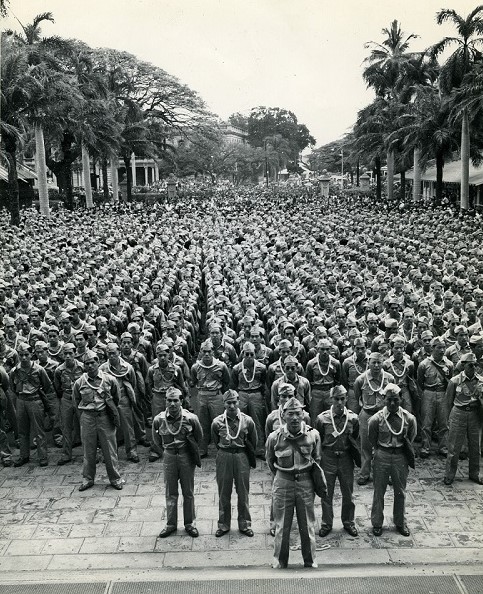
442d Regimental Combat Team Enlistment at Iolani Palace, Honolulu, Hawaii. Nika Nashiro | Department of Defense
How to register:
We offer two field trip scheduling options:
- Select a field trip from the Museum’s public event schedule
- Request to schedule a field trip at a time that meets your group’s schedule
Audience: All audiences. Content appropriate for Grades 6-12.
Goal: Recognize the commitment, challenges, and sacrifices of Nisei Soldiers.
Program Description:
Learn about the courageous men and women of Japanese ancestry from Hawaii and the mainland United States who served in the U.S. Army during World War II, while some of their families were placed in War Relocation Authority Confinement Sites.
Second generation Japanese Americans, known as Nisei, demanded the right to join the armed forces during World War II. On February 9, 1942, President Franklin Roosevelt ordered the relocation of Japanese Americans living on the west coast. 122,000 men, women, and children were sent to incarceration camps throughout the United States. Further, the government classified males of Japanese ancestry as enemy aliens. This classification disqualified them from military service. The Army later loosened this restriction in June 1942. Despite the odds, thousands of Nisei Soldiers bravely served in World War II.
During this Virtual Field Trip, explore the commitment, challenges, and sacrifices of the Nisei Soldiers. Participant will also examine Executive Order 9906, its impact on Japanese Americans living on the west coast and how military service was used as a strategy to advance civil rights.
Objective: At the end of this lesson students, will be able to
- Recognize the commitment, challenges, and sacrifices of Nisei Soldiers during World War II.
- Define Executive Order 9906 and describe its impact on Japanese Americans during World War II.
- Understand how military services has been used as a strategy to advance civil rights.
Guiding Questions:
What can the experiences of Nisei Soldiers during World War II tell us about freedom and democracy?
Curriculum Connections
Common Core Standards
- CCSS.ELA-LITERACY.RH.6-8.2
Determine the central ideas or information of a primary or secondary source; provide an accurate summary of the source distinct from prior knowledge or opinions.
History and Social Science Standards of Learning for Virginia Public Schools
-
United States History 1865 to Present
-
USII.6 The student will apply history and social science skills to understand the major causes and events of World War II and the effects of America’s role by
- F) identifying the roles and sacrifices of American armed forces, including prisoners of war, women, and segregated units, as well as other notable heroics, including, but not limited to the contributions of the Tuskegee Airmen, the 442nd Regimental Combat Team, Women’s Army Auxiliary Corps, the Women Airforce Service Pilots, the Navajo Code Talkers, and the Bedford boys.
-
USII.6 The student will apply history and social science skills to understand the major causes and events of World War II and the effects of America’s role by
-
Virginia and United States History
-
VUS.14 The student will apply history and social science skills to analyze the United States’ involvement in World War II by
- B) analyzing the causes and events that led to America’s involvement, including the attack on Pearl Harbor, the U.S. response with Executive Order 9066 and the incarceration of Japanese Americans, and the Supreme Court case Korematsu v. United States.
- D) evaluating and explaining the contributions of heroic military units including, but not limited to segregated, minority units, women, and the role of Virginia units in the American war effort.
-
VUS.14 The student will apply history and social science skills to analyze the United States’ involvement in World War II by
Your message has been submitted.
